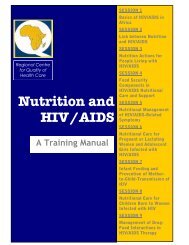2.1: Anthropometric Indicators Measurement Guide - Linkages Project
2.1: Anthropometric Indicators Measurement Guide - Linkages Project
2.1: Anthropometric Indicators Measurement Guide - Linkages Project
You also want an ePaper? Increase the reach of your titles
YUMPU automatically turns print PDFs into web optimized ePapers that Google loves.
REFERENCES PART 9.<br />
minants of nutrition are so many, it is<br />
important to examine other factors than<br />
just anthropometry such as the food<br />
security situation, levels of illness, care<br />
giving practices and so on.<br />
For assessing women’s nutrition status,<br />
usually, a combination of indicators is<br />
needed. Unlike children, reference data<br />
have not been standardized for women. For<br />
cross-sectional comparisons, reference<br />
data can be gathered from within the same<br />
population that the intervention group<br />
belongs to among healthy women, women<br />
with positive pregnancy outcomes.<br />
Construction of an adult nutrition reference<br />
has been done for some populations.<br />
Each anthropometric indicator listed for<br />
adults and especially for women has its<br />
own advantages and limitations. To<br />
determine the best indicator, one should<br />
consider the objectives of the nutrition<br />
program and its associated reporting<br />
requirements. Several possible uses of<br />
indicators are:<br />
4.1 Height<br />
Adults are not growing in stature. Height<br />
in adults is determined by a person’s<br />
genetic potential and the health and<br />
nutrition experiences dating back to the<br />
fetus. Most growth in height is completed<br />
by age 17 with some incremental growth<br />
for another 10 years. Height, therefore,<br />
may be useful for a reflection of past<br />
events and be used in some screening<br />
situations, but will not be able to reflect<br />
recent or current nutritional shocks or<br />
change. Women’s height is a useful<br />
predictor of pregnancy outcomes such as<br />
low birth weight and possible delivery<br />
complications; thus it is an indicator of<br />
risk. Because height will change very little<br />
among adult women, it is not useful for<br />
evaluating interventions (outcome).<br />
Height can not be used for monitoring and<br />
evaluation of programs.<br />
Adult Measuring Device (Microtoise) -<br />
(UNICEF No. 0114400 Height measuring<br />
instrument (0-2 m)) This lightweight<br />
portable tape is wall mounted and fits<br />
easily into the package needed for field<br />
measurements. Made of plastic, the<br />
Microtoise measures up to 2 meters and is<br />
available for approximately $US20. Refer<br />
to the local UNICEF office for<br />
procurement options.<br />
Adult Measuring Device - An<br />
inexpensive height measuring device<br />
useful for children over 24 months and<br />
adults is the Harpenden pocket<br />
stadiometer (range 0-2m) available from<br />
CMS weighing equipment. The cost is<br />
approximately $US100. CMS Weighing<br />
Equipment, Ltd., 18 Camden High School,<br />
London NW1 OJH, U.K.; Telephone: 01-<br />
387-2060 (international) +44 171 387 2060.<br />
4.2 Weight<br />
Weight does change reflecting recent<br />
events. For monitoring change in an<br />
individual, weight change is helpful as<br />
height would not be expected to change.<br />
For controlled studies where the same<br />
participants are being followed and height<br />
would not be changing, weight can be<br />
used for screening and evaluation<br />
purposes. More than one measurement is<br />
necessary for tracking changes.<br />
For women who are pregnant, weight<br />
gains of 1.5 kg/month during the last two<br />
trimesters are consistent with positive<br />
pregnancy outcomes in developing<br />
countries. Short maternal stature, low<br />
pregnant BMI and poor weight gain<br />
during pregnancy are all indicators of risk<br />
for low birth weight. As stated above, not<br />
all of these are indicators of outcome.<br />
For comparing within or across<br />
groups, an interpretation of weight change<br />
needs to be done controlling for the<br />
variation in height. The most common<br />
indicator used to control for height and to<br />
reflect body mass is referred to as the body<br />
mass index (BMI). There are limitations<br />
in the use of this indicator.<br />
Scales are used to weigh adults and can be<br />
obtained from various sources. Ensure<br />
the scale is sturdy, reliable and accurate.<br />
9.<br />
75

















